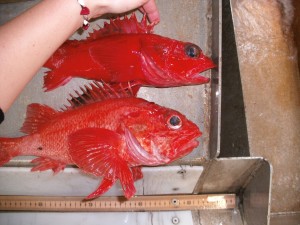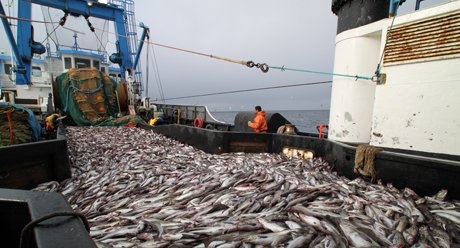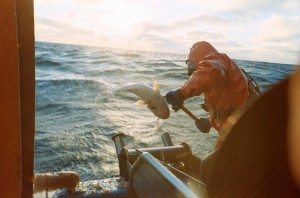Fisheries Observers: an Important Enforcement Tool
By: Read Porter, Senior Attorney, Director of Invasive Species Program
October 30, 2014

- A fisheries observer analyzes two specimens. Top: short spine thorny head. Bottom: rare broad banded thorny head. Credit: Johanna Marsters
Fisheries observers serve important roles in fisheries management. From a scientific perspective, they provide independent verification of the amounts and types of fish caught, providing key data for stock assessment. In some fisheries, observers also have an important enforcement function: they report to law enforcement when they witness violations of fisheries regulations. In 2010, I published an article, based on NOAA’s enforcement data, showing that observer reports are a key source of information for understanding fishers’ compliance while at sea. With observer information, enforcement agents can take action to investigate and prosecute violators who are undermining fishery sustainability, and fisheries managers can design better regulatory systems to increase compliance.
Just last week, NOAA lawyers successfully concluded three cases for $1.75 million against American Seafoods Company (ASC). Observers first broke the case when they noticed and reported that ASC was tampering with the scales on its massive pollock fishing vessels. As a result, ASC caught more fish than it was allowed to over a five-year period, overfishing and threatening the long-term sustainability of the world’s second largest fishery—a resource that provides filet-o-fish sandwiches for McDonald’s, artificial crab meat for sushi, fish fingers for Bird’s Eye, and many other products. Observer reports led to an investigation by the Office of Law Enforcement (OLE) and eventually to a case prosecuted by NOAA’s General Counsel. What can we learn from this case?
1. We need a strong fisheries enforcement program to ensure that fisheries are as sustainable in practice as they are on paper.
2. Observers are a critical component of fisheries enforcement systems.
Unfortunately, with some exceptions, US fisheries managers are ignoring both lessons. After a multi-year, comprehensive review of OLE practices, NOAA is still struggling to enforce the law—especially in areas like New England where the need is greatest due to the collapse of Atlantic cod and other groundfish.[i] Without strong and effective enforcement, these and other fisheries are seeing substantial illegal fishing that undermines stock rebuilding and sustainability. In addition, US observers are only required to report violations in the North Pacific—even though ELI’s work and enforcement cases like the one settled last week clearly show the value of observers for enforcement.
Managers in other regions have fought to limit the use of observers for any purpose other than science. First, some opponents of the idea argue that observer reporting would bias the scientific data that observers collect because it would change the way fishers act. However scientific evidence already shows that fishers behave differently when there is an observer on board, regardless of that observer’s role—in other words, the data collection is already biased.
Second, opponents argue that observer reporting could result in physical danger to observers from fishers. Observers face many dangers at sea—and sadly, this sometimes includes danger from fishers who view observers as unwelcome guests on fishing vessels. Our data show that observers around the U.S. regularly report harassment. North Pacific observers report harassment and interference more than twice as often as observers in other regions [ii]—so concern about observer safety in a mandatory-enforcement-reporting world are worth taking seriously. However, more work is needed to determine if this difference is a result of an increase in threats to or actions against observers or if there is some other cause—for example, observers trained to report violations may be more aware of what conduct constitutes harassment and more willing to report these violations when they occur. In the meantime, the answer is not to strip observers of responsibility, but to ensure that harassment and interference reports are investigated and prosecuted swiftly and seriously.
The time is ripe for Congress, NOAA, and regional fishery management councils to move forward together to strengthen fishery enforcement by requiring observers to report violations that they witness, and by committing to protect observers while they are at sea.
LEARN MORE:
http://eli-ocean.org/fish/compliance-and-enforcement/
———————————————
[i] Gulf of Maine cod is at an all-time low—just 3-4% of the population needed for a healthy stock.
[ii] Based on NOAA enforcement data and information on sea-days sourced from the National Observer Program FY 2012 Annual Report, observers report one harassment violation every 275 sea-days versus one in 641 days elsewhere, and an interference claim once in 155 days in the North Pacific versus one every 412 elsewhere.


